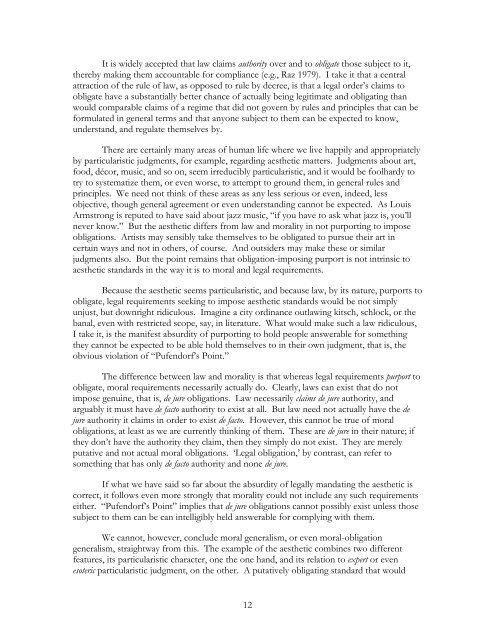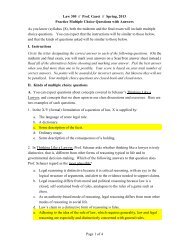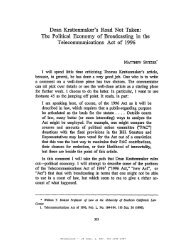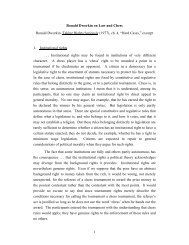1 MORALITY AND PRINCIPLE Jonathan Dancy is largely ...
1 MORALITY AND PRINCIPLE Jonathan Dancy is largely ...
1 MORALITY AND PRINCIPLE Jonathan Dancy is largely ...
You also want an ePaper? Increase the reach of your titles
YUMPU automatically turns print PDFs into web optimized ePapers that Google loves.
It <strong>is</strong> widely accepted that law claims authority over and to obligate those subject to it,thereby making them accountable for compliance (e.g., Raz 1979). I take it that a centralattraction of the rule of law, as opposed to rule by decree, <strong>is</strong> that a legal order’s claims toobligate have a substantially better chance of actually being legitimate and obligating thanwould comparable claims of a regime that did not govern by rules and principles that can beformulated in general terms and that anyone subject to them can be expected to know,understand, and regulate themselves by.There are certainly many areas of human life where we live happily and appropriatelyby particular<strong>is</strong>tic judgments, for example, regarding aesthetic matters. Judgments about art,food, décor, music, and so on, seem irreducibly particular<strong>is</strong>tic, and it would be foolhardy totry to systematize them, or even worse, to attempt to ground them, in general rules andprinciples. We need not think of these areas as any less serious or even, indeed, lessobjective, though general agreement or even understanding cannot be expected. As Lou<strong>is</strong>Armstrong <strong>is</strong> reputed to have said about jazz music, “if you have to ask what jazz <strong>is</strong>, you’llnever know.” But the aesthetic differs from law and morality in not purporting to imposeobligations. Art<strong>is</strong>ts may sensibly take themselves to be obligated to pursue their art incertain ways and not in others, of course. And outsiders may make these or similarjudgments also. But the point remains that obligation-imposing purport <strong>is</strong> not intrinsic toaesthetic standards in the way it <strong>is</strong> to moral and legal requirements.Because the aesthetic seems particular<strong>is</strong>tic, and because law, by its nature, purports toobligate, legal requirements seeking to impose aesthetic standards would be not simplyunjust, but downright ridiculous. Imagine a city ordinance outlawing kitsch, schlock, or thebanal, even with restricted scope, say, in literature. What would make such a law ridiculous,I take it, <strong>is</strong> the manifest absurdity of purporting to hold people answerable for somethingthey cannot be expected to be able hold themselves to in their own judgment, that <strong>is</strong>, theobvious violation of “Pufendorf’s Point.”The difference between law and morality <strong>is</strong> that whereas legal requirements purport toobligate, moral requirements necessarily actually do. Clearly, laws can ex<strong>is</strong>t that do notimpose genuine, that <strong>is</strong>, de jure obligations. Law necessarily claims de jure authority, andarguably it must have de facto authority to ex<strong>is</strong>t at all. But law need not actually have the dejure authority it claims in order to ex<strong>is</strong>t de facto. However, th<strong>is</strong> cannot be true of moralobligations, at least as we are currently thinking of them. These are de jure in their nature; ifthey don’t have the authority they claim, then they simply do not ex<strong>is</strong>t. They are merelyputative and not actual moral obligations. ‘Legal obligation,’ by contrast, can refer tosomething that has only de facto authority and none de jure.If what we have said so far about the absurdity of legally mandating the aesthetic <strong>is</strong>correct, it follows even more strongly that morality could not include any such requirementseither. “Pufendorf’s Point” implies that de jure obligations cannot possibly ex<strong>is</strong>t unless thosesubject to them can be can intelligibly held answerable for complying with them.We cannot, however, conclude moral general<strong>is</strong>m, or even moral-obligationgeneral<strong>is</strong>m, straightway from th<strong>is</strong>. The example of the aesthetic combines two differentfeatures, its particular<strong>is</strong>tic character, one the one hand, and its relation to expert or evenesoteric particular<strong>is</strong>tic judgment, on the other. A putatively obligating standard that would12
















